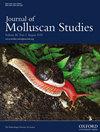Comparative analysis of three families of hygrophilid snails shows that the egg mass fluid protein haemocyanin-like 1 (Hcl-1) is unique to planorbids
IF 1.2
4区 生物学
Q2 MARINE & FRESHWATER BIOLOGY
引用次数: 1
Abstract
The egg mass fluid (EMF) of the freshwater snail Biomphalaria glabrata (Hygrophila: Planorbidae) contains haemocyanin-like 1 (Hcl-1) protein, distinct from respiratory haemocyanins. The distribution of Hcl-1 was investigated among major families of Hygrophila, Physidae and Lymnaeidae, both of which employ respiratory haemocyanins, and Planorbidae, a group that evolved haemoglobin as a respiratory pigment. Immunoblotting detected c. 150 kDa protein (molecular weight of Hcl-1) cross-reactive with anti-keyhole limpet haemocyanin antiserum in the EMF of planorbids Bulinus globosus and Planorbella duryi (from a genus closely related to Biomphalaria), but not Physella acuta (Physidae) and Ladislavella elodes (Lymnaeidae). High throughput sequence data revealed Hcl-1 homologs from Bulinus globosus and Planorbella duryi, representative species that span the range of planorbid phylogeny, but not from Physella acuta (Physidae) and Lymnaea stagnalis (Lymnaeidae). A domain architecture comprising only three functional units (FUs) and predicted secondary structures within the C-terminal FU distinguish planorbid Hcl-1 protein from molluscan respiratory haemocyanins that are natively assembled as functional didecamers. Immunoblotting confirmed a monomeric configuration of native Hcl-1. Molecular clock analysis estimated divergence of Hcl-1 proteins from gastropod respiratory haemocyanins at 267 ± 143 Ma. It is hypothesized that Hcl proteins originated in the ancestor of the planorbid lineage when evolution of respiratory haemoglobin altered selective pressures for maintaining original function, facilitating mutation and refunctionalization of the ancestral respiratory haemocyanin in Planorbidae.对三个亲水性蜗牛科的比较分析表明,卵团液蛋白血红素样1 (Hcl-1)是planorbids所特有的
淡水蜗牛Biophalaria glabrata(Hygrophila:Planorbidae)的卵块液(EMF)含有血蓝蛋白样1(Hcl-1)蛋白,与呼吸血蓝蛋白不同。Hcl-1在Hygrophila、Physidae和Lymnaedae的主要家族中的分布进行了研究,这两个家族都使用呼吸血蓝蛋白,而Planorbidae是一个进化血红蛋白作为呼吸色素的群体。免疫印迹法检测到球扁球藻和杜氏扁球藻(来自一个与Biomphalaria密切相关的属)的EMF中c.150kDa蛋白(分子量为Hcl-1)与抗锁孔帽贝血蓝蛋白抗血清发生交叉反应,但不检测到尖尾藻(Physella acuta)和垂尾藻(Ladislavella elodes)(Lymnaedae)。高通量序列数据显示,Hcl-1同源物来自球球藻(Bulinus globosus)和杜氏扁球藻(Planorbella duryi。仅包含三个功能单元(FU)的结构域结构和C末端FU内预测的二级结构将平轨道Hcl-1蛋白与软体动物呼吸血蓝蛋白区分开来,后者被天然组装为功能性二聚体。免疫印迹证实了天然Hcl-1的单体构型。分子钟分析估计Hcl-1蛋白与腹足类呼吸血蓝蛋白的差异为267±143Ma。据推测,当呼吸血红蛋白的进化改变了维持原始功能的选择压力时,Hcl蛋白起源于平眶谱系的祖先,促进Planorbidae中祖先呼吸血蓝蛋白的突变和再功能化。
本文章由计算机程序翻译,如有差异,请以英文原文为准。
求助全文
约1分钟内获得全文
求助全文
来源期刊

Journal of Molluscan Studies
生物-动物学
CiteScore
3.00
自引率
8.30%
发文量
36
审稿时长
3 months
期刊介绍:
The Journal of Molluscan Studies accepts papers on all aspects of the study of molluscs. These include systematics, molecular genetics, palaeontology, ecology, evolution, and physiology. Where the topic is in a specialized field (e.g. parasitology, neurobiology, biochemistry, molecular biology), submissions will still be accepted as long as the mollusc is the principal focus of the study, and not incidental or simply a convenient experimental animal. Papers with a focus on fisheries biology, aquaculture, and control of molluscan pests will be accepted only if they include significant advances in molluscan biology. While systematic papers are encouraged, descriptions of single new taxa will only be considered if they include some ‘added value’, for example in the form of new information on anatomy or distribution, or if they are presented in the context of a systematic revision or phylogenetic analysis of the group.
 求助内容:
求助内容: 应助结果提醒方式:
应助结果提醒方式:


